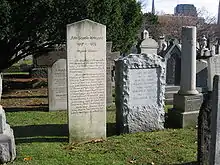John Gamble Kirkwood
John "Jack" Gamble Kirkwood (May 30, 1907, Gotebo, Oklahoma – August 9, 1959, New Haven, Connecticut) was a noted chemist and physicist, holding faculty positions at Cornell University, the University of Chicago, California Institute of Technology, and Yale University.
Early life and background
Kirkwood was born in Gotebo, Oklahoma, the oldest child of John Millard and Lillian Gamble Kirkwood. His father was educated as an attorney and worked as a distributor for the Goodyear Corporation. In addition to Jack Kirkwood, there were two younger sisters: Caroline and Margaret.
In 1909, the family moved to Wichita, Kansas.

Education
Showing remarkable talent in mathematics and physics, Kirkwood was persuaded by A. A. Noyes to enroll at Caltech before finishing his high school education. He attended Caltech for two years before transferring to the University of Chicago, where he was awarded his Bachelor of Science in 1926.
Academic career
Kirkwood received an S.B. in Physics from the University of Chicago in 1926, and a Ph.D. in Chemistry from MIT in 1929, where he worked with Frederick G. Keyes. He spent two years in Europe, where he worked with Peter Debye and visited Arnold Sommerfeld.
He returned to MIT for the period 1932-1934 as a Research Associate in Physical Chemistry. There, with Frederick G. Keyes, he mentored Herbert H. Uhlig, who subsequently became a noted physical chemist, specializing in the study of corrosion. Kirkwood won the 1936 Langmuir Award in recognition of his status as the best young chemist in the United States.[1] In the same year he was awarded the American Chemical Society Award in Pure Chemistry.[2]
In his classic 1939 paper “The Dielectric Polarization of Polar Liquids,” Kirkwood introduced for the first time the concept of orientational correlations for neighboring molecules and showed how these control the dielectric behavior of liquids.[3]
The year 1946 was especially notable for the appearance of the first paper in a long series that Kirkwood and his collaborators devoted to the fundamental statistical mechanical theory of transport processes.[4][5][6][7]
Kirkwood was elected to the National Academy of Sciences in 1942.
Notes
- "Produces a fiber a third thinner than natural silk", The New York Times. April 14, 1936. Page 1.
- "ACS Award in Pure Chemistry". American Chemical Society. Retrieved 18 January 2014.
- Kirkwood, John G. (1939). "The Dielectric Polarization of Polar Liquids". The Journal of Chemical Physics. 7 (10): 911–919. doi:10.1063/1.1750343. ISSN 0021-9606.
- Kirkwood, John G. (1946). "The Statistical Mechanical Theory of Transport Processes I. General Theory". The Journal of Chemical Physics. 14 (3): 180–201. doi:10.1063/1.1724117. ISSN 0021-9606.
- Kirkwood, John G. (1947). "The Statistical Mechanical Theory of Transport Processes II. Transport in Gases". The Journal of Chemical Physics. 15 (1): 72–76. doi:10.1063/1.1746292. ISSN 0021-9606.
- Kirkwood, John G.; Buff, Frank P.; Green, Melvin S. (1949). "The Statistical Mechanical Theory of Transport Processes. III. The Coefficients of Shear and Bulk Viscosity of Liquids". The Journal of Chemical Physics. 17 (10): 988–994. doi:10.1063/1.1747099. ISSN 0021-9606.
- Irving, J. H.; Kirkwood, John G. (1950). "The Statistical Mechanical Theory of Transport Processes. IV. The Equations of Hydrodynamics". The Journal of Chemical Physics. 18 (6): 817–829. doi:10.1063/1.1747782. ISSN 0021-9606.
References
- George Scatchard (1960). "John Gamble Kirkwood 1907–1959". The Journal of Chemical Physics. 33 (5): 1279–1281. Bibcode:1960JChPh..33.1279S. doi:10.1063/1.1731400.